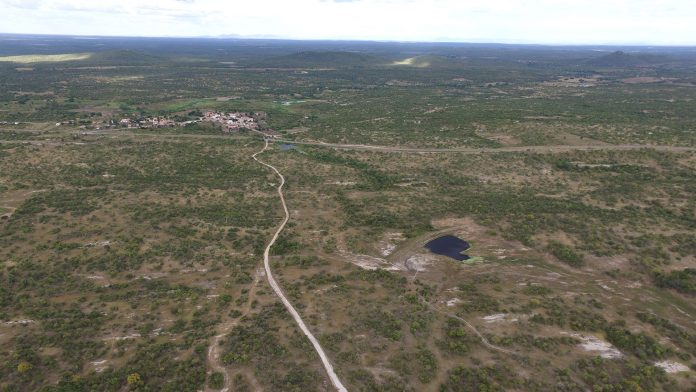The Brazilian government’s recent announcement that it will allow unrestricted foreign trade of lithium minerals and ores and their derivatives is welcome news for emerging battery metals exploration company Oceana Lithium.
Within a few days of successfully listing on the Australian Securities Exchange at the end of June, emerging battery metals explorer Oceana Lithium welcomed some positive news out of Brazil, home to its flagship Solonopole Lithium Project.
Under a Government Decree issued by the Ministry for Mines and Energy (Ministerio de Minas e Energia), the Brazilian government announced it would allow unrestricted foreign trade of lithium minerals and ores and their derivatives.
As Oceana is just getting started with exploration at Solonopole, the regulatory change did not immediately impact the company. However, it did send a positive message about the government’s support for the future of lithium exploration and upstream project development in the country.
Jerome Vitale, Chairman of Oceana Lithium, said: “The decree from the Brazilian government really was a sign that they are committed to modernising the country’s lithium industry and making it more attractive to foreign investors.
“Previously, the industry was tightly regulated through requirements for quotas and export authorisations. Now we have the Mines and Energy Minister describing Brazil as a lithium ‘safe haven’.
“There is a clear belief at government level that the country can become a global player in lithium production and that is a view that Oceana shares.”
Brazilian lithium production
While not quite at the same level of Australia, Chile or China, Brazil does produce lithium concentrates from operations run by AMG Mineracao, a subsidiary of German vertically intergrated AMG Advanced Metallurgical Group and local player Companhia Brasileira de Litio.
Both of these operations are located in the southern state of Minas Gerais, a mining-friendly jurisdiction that hosts the giant iron ore mines that national mining champion Vale was built on.
Also in Minas Gerais is the Groto do Cirilo lithium project, which is being developed by TSX and NASDAQ-listed Sigma Lithium Corporation. Sigma has grown into a C$2.1bn company on the back of its progress with Groto do Cirilo, which could be the fourth largest lithium mine in the world at peak production.
Solonopole project
Oceana’s Solonopole project is in Ceara State in Brazil’s northeast – the country’s other historical lithium mining region. The permits cover 114km2 of highly prospective ground that has been previously worked by artisanal miners for lithium, tantalum, niobium, and tin to depths of less than 10m.
Detailed field mapping undertaken by Oceana’s Brazilian subsidiary Ceara Litio has identified an approximate 17km of outcropping mineralised pegmatites within the Solonopole landholding. These pegmatites are currently being mapped, with infill soil geochemistry across a 50m-by-20m grid also being carried out by the in-country team.
“Though richly endowed and second only to Australia in bulk export commodities like high grade iron ore, Brazil is relatively underexplored compared to Australia and there is a huge amount of untapped potential for new lithium discoveries,” Vitale said.
While investment in the lithium sector is being encouraged, industrial activity in Ceara State appears to be increasing in general – some of it with the potential to assist Oceana in progressing Solonopole.
The project is about three hours’ drive along sealed roads from Ceara’s capital, Fortaleza, and just up the road is the port of Pecem, which has recently expanded on the back of more than C$200m worth of state investment.
Furthermore, in July 2021, Australian company Fortescue Future Industries signed a memorandum of understanding (MoU) with the Ceara government to assess the opportunity to develop large-scale hydrogen-based green industrial projects in the state.
The Oceana board and management team have pedigree in lithium exploration, mining, processing and marketing, with a strong connection to Galaxy Resources, the ASX-listed company that merged with Orocobre to form A$7bn lithium miner Allkem.
Oceana’s Executive Director, Sebastian Kneer, was Geology Manager at Galaxy, responsible for all hard rock lithium exploration and resource development in Australia and Canada, while Non-Executive Director Dr Qingtao Zeng assisted Galaxy in marketing its spodumene concentrate to customers overseas.
The connection extends to technical consultant Brian Talbot, once General Manager of Galaxy’s Mt Cattlin mine in Western Australia, and Advisor Nick Rowley, who led Galaxy’s business development efforts.
Brazil resident and geologist Simon Mottram, who was part of the executive team that took Avanco Resources from a junior copper explorer through to being bought out for A$440m in 2018, also represents Oceana as a Non-Executive Director, providing valuable in-country knowledge and intelligence.
Rounding out the board is Chairman Gino Vitale, who has more than 30 years’ experience in operational, investment banking, and advisory roles within the mining industry.
Napperby Lithium Project
It was Dr Zeng that introduced Oceana’s second asset, the 1160km2 Napperby Lithium Project in Australia’s Northern Territory to the company ahead of its ASX listing.
The NT Geological Survey identified lithium-caesium-tantalum pegmatites at Napperby, which lies north of Alice Springs in the Northern Arunta Province, in 2005.
Given the larger project area relative to Solonopole, early work at Napperby will be geared towards mapping and sampling to get a better understanding on the project potential and hone in on the areas that hold the most promise.
Oceana raised $6m in its initial public offering, which will ensure it is well-funded to conduct exploration concurrently on its Brazilian and Australian assets.
As part of the raising, top three Chinese lithium hydroxide producer and Tesla supplier Ya Hua International committed $1m for a cornerstone 7.76% stake in the company.
Please note, this article will also appear in the eleventh edition of our quarterly publication.







